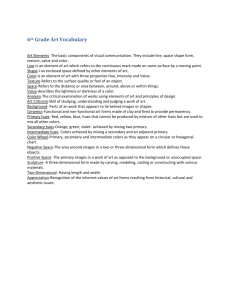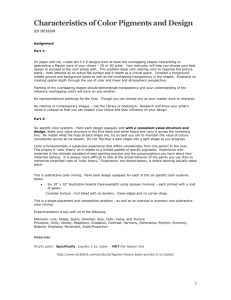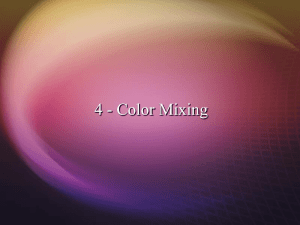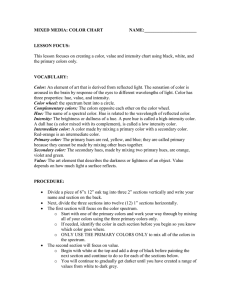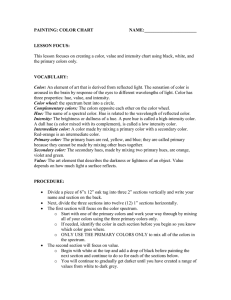color theory lecture
advertisement
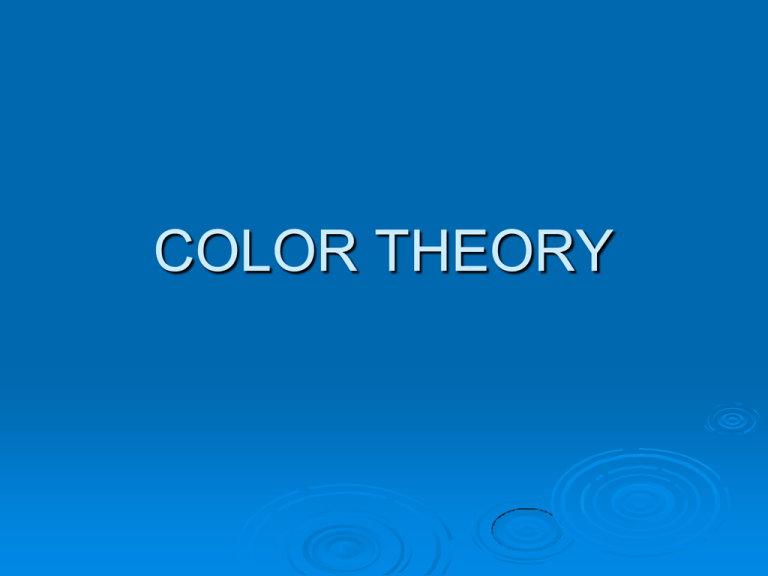
COLOR THEORY What is Color? We perceive light as being white Visible spectrum Color Perception Rainbow (Sir Issac Newton) Moisture in the air causes visible light to be separated. VISIBLE LIGHT SPECTRUM A small part of the electromagnetic spectrum. Measured in Nanometers (one billionth of a meter) 400-700 is the visible color spectrum. This is what the human eye can see. Red-Orange-Yellow-Green-Blue-Indigo-Violet (Roy G Biv) All these colors mix to make white light. Below violet(400) is Ultraviolet. Above Red (700) is infrared. PHOTO Basic Color Terminology Hue (Position of a color in the spectrum.) Saturation How pure the hue is. Primary red is the most saturated version of red. Value Dominant wavelength. A measurement of the amount of light reflected from a hue. Hues with a higher amount of white have a higher value. Brightness of the color Chroma How pure a hue is in relationship to gray The lightness of a color , light blue or pastel blue. PHOTO Using Color Dominant Vs. Recessive The color with the highest value or brightest source will dominate the scene. Warm colors often dominate cool colors. Lavender is the hardest to perceive. • Lavender is a tone and difficult for our eyes to see. • Lavender can act as a warm or cool color. The Human Eye The eye consists of four types of receptors. Everybody perceives light differently. Rods Three cones COLOR MIXING ADDITIVE COLOR MIXING SUBTRACTIVE COLOR MIXING Color Reflection Unlike Wavelengths absorb and like wavelengths reflect. A red rose will only reflect red light. Depending how much red a rose reflect depends on the amount of red in the light source. All atoms and molecules have their own natural frequencies. Color Fatigue When you focus on a strong predominent light source, your photoreceptors become desensitized to that color. After Image This process of desentizing will create an after immage. Stare at the eye of the red parrot while you slowly count to 20, then immediately look at one spot in the empty birdcage. The faint, ghostly image of a blue-green bird should appear in the cage. Try the same thing with the green cardinal, and a faint magenta bird should appear. Rods Sensitive to black, white and shades of grey. Rod receptors are less sensitive than cone receptors. Rod receptors function in low light. This is the reason for temporary blindness when you move from a bright area to a dark area. The rods need time to adjust. Back Cones The human eye has three cones that respond to different colors. Red, Green and Blue-Violet Blue violet cones are less sensitive light. Twice as much light is needed to obtain the same results. There is and overlap between cone response especially red and blue. Back Visible Light Spectrum BACK ADDITIVE COLOR MIXING As more color is added, the closer to white we get. Three additive primaries Red Blue Green Artist who use light with more than one source use additive color mixing. Digital artists use additive color mixing. The colors on the screen are made by light. PHOTO BACK Subtractive Color Mixing Begins with white and ends with black. As an artists adds color, the pigment gets darker and darker. Subtractive Primary Colors for paint Red, Blue, and Yellow Subtractive Primary Colors for printing Cyan, Yellow, and Magenta Used when dealing with reflected light. Artist who deal with pigment use subtractive color mixing. Printers use subtractive color mixing. PHOTO PHOTO BACK ADDITIVE COLOR MIXING BACK HUE These are examples of six different hues. There are many More possibilities. BACK VALUE Different values of red, Magenta and blue. BACK SATURATION Different saturations of red, magenta and blue With a medium value. BACK CHROMA BACK HUE, VALUE, CHROMA Hues change as you move around the center. Value changes from top-to-bottom; Chroma changes as you move from the center outward. SUBTRACTIVE COLOR MIXING BACK CMY COLOR MIXING BACK
